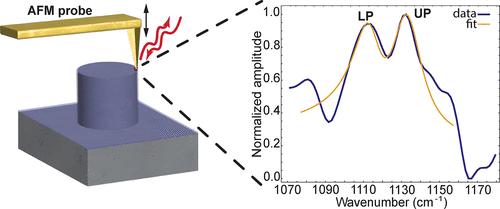当前位置:
X-MOL 学术
›
ACS Photonics
›
论文详情
Our official English website, www.x-mol.net, welcomes your feedback! (Note: you will need to create a separate account there.)
Spatially Resolved Near Field Spectroscopy of Vibrational Polaritons at the Small N Limit
ACS Photonics ( IF 6.5 ) Pub Date : 2024-06-20 , DOI: 10.1021/acsphotonics.4c00345 Oliver Hirschmann 1 , Harsh H. Bhakta 1 , Wilton J. M. Kort-Kamp 2 , Andrew C. Jones 3 , Wei Xiong 1, 4, 5
ACS Photonics ( IF 6.5 ) Pub Date : 2024-06-20 , DOI: 10.1021/acsphotonics.4c00345 Oliver Hirschmann 1 , Harsh H. Bhakta 1 , Wilton J. M. Kort-Kamp 2 , Andrew C. Jones 3 , Wei Xiong 1, 4, 5
Affiliation

|
Vibrational polaritons, which have been primarily studied in Fabry–Pérot cavities with a large number of molecules (N ∼ 106–1010) coupled to the resonator mode, exhibit various experimentally observed effects on chemical reactions. However, the exact mechanism is elusively understood from the theoretical side, as the large number of molecules involved in an experimental strong coupling condition cannot be represented completely in simulations. This discrepancy between theory and experiment arises from computational descriptions of polariton systems typically being limited to only a few molecules, thus failing to represent the experimental conditions adequately. To address this mismatch, we used surface phonon polariton (SPhP) resonators as an alternative platform for vibrational strong coupling. SPhPs exhibit strong electromagnetic confinement on the surface and thus allow for coupling to a small number of molecules. As a result, this platform can enhance nonlinearity and slow down relaxation to the dark modes. In this study, we fabricated a pillar-shaped quartz resonator and then coated it with a thin layer of cobalt phthalocyanine (CoPc). By employing scattering-type scanning near-field optical microscopy (s-SNOM), we spatially investigated the dependency of vibrational strong coupling on the spatially varying electromagnetic field strength and demonstrated strong coupling with 38,000 molecules only─reaching to the small N limit. Through s-SNOM analysis, we found that strong coupling was observed primarily on the edge of the quartz pillar and the apex of the s-SNOM tip, where the maximum field enhancement occurs. In contrast, a weak resonance signal and lack of coupling were observed closer to the center of the pillar. This work demonstrates the importance of spatially resolved polariton systems in nanophotonic platforms and lays a foundation to explore polariton chemistry and chemical dynamics at the small N limit─one step closer to reconcile with high-level quantum calculations.
中文翻译:

小 N 极限下振动极化子的空间分辨近场光谱
振动极化激元主要在具有大量分子 (N ∼ 10 6 –10 10 ) 的法布里-珀罗腔中与谐振器模式耦合进行研究,表现出各种实验观察到的现象对化学反应的影响。然而,从理论角度很难理解确切的机制,因为实验强耦合条件中涉及的大量分子无法在模拟中完全表示。理论和实验之间的这种差异是由于极化子系统的计算描述通常仅限于几个分子,因此无法充分代表实验条件。为了解决这种不匹配问题,我们使用表面声子极化子(SPhP)谐振器作为振动强耦合的替代平台。 SPhP 在表面上表现出很强的电磁限制,因此允许与少量分子耦合。因此,该平台可以增强非线性并减缓暗模式的弛豫。在这项研究中,我们制造了一个柱形石英谐振器,然后在其上涂上一层薄薄的钴酞菁(CoPc)。通过采用散射型扫描近场光学显微镜 (s-SNOM),我们在空间上研究了振动强耦合对空间变化电磁场强度的依赖性,并证明了仅与 38,000 个分子的强耦合 — 达到了小 N 极限。通过 s-SNOM 分析,我们发现强耦合主要出现在石英柱边缘和 s-SNOM 尖端的顶点,此处发生最大场增强。相反,在靠近柱子中心的地方观察到弱共振信号和缺乏耦合。 这项工作证明了空间分辨极化子系统在纳米光子平台中的重要性,并为探索小氮极限下的极化子化学和化学动力学奠定了基础,离与高级量子计算一致又近了一步。
更新日期:2024-06-21
中文翻译:

小 N 极限下振动极化子的空间分辨近场光谱
振动极化激元主要在具有大量分子 (N ∼ 10 6 –10 10 ) 的法布里-珀罗腔中与谐振器模式耦合进行研究,表现出各种实验观察到的现象对化学反应的影响。然而,从理论角度很难理解确切的机制,因为实验强耦合条件中涉及的大量分子无法在模拟中完全表示。理论和实验之间的这种差异是由于极化子系统的计算描述通常仅限于几个分子,因此无法充分代表实验条件。为了解决这种不匹配问题,我们使用表面声子极化子(SPhP)谐振器作为振动强耦合的替代平台。 SPhP 在表面上表现出很强的电磁限制,因此允许与少量分子耦合。因此,该平台可以增强非线性并减缓暗模式的弛豫。在这项研究中,我们制造了一个柱形石英谐振器,然后在其上涂上一层薄薄的钴酞菁(CoPc)。通过采用散射型扫描近场光学显微镜 (s-SNOM),我们在空间上研究了振动强耦合对空间变化电磁场强度的依赖性,并证明了仅与 38,000 个分子的强耦合 — 达到了小 N 极限。通过 s-SNOM 分析,我们发现强耦合主要出现在石英柱边缘和 s-SNOM 尖端的顶点,此处发生最大场增强。相反,在靠近柱子中心的地方观察到弱共振信号和缺乏耦合。 这项工作证明了空间分辨极化子系统在纳米光子平台中的重要性,并为探索小氮极限下的极化子化学和化学动力学奠定了基础,离与高级量子计算一致又近了一步。






































 京公网安备 11010802027423号
京公网安备 11010802027423号